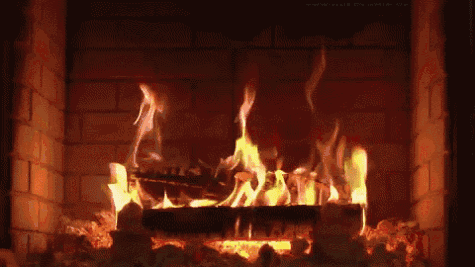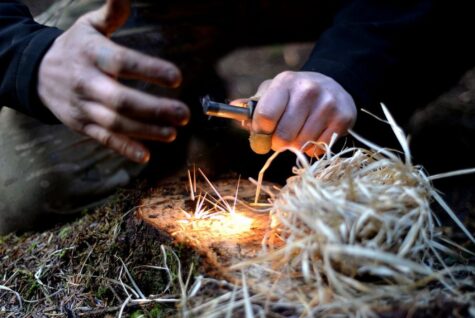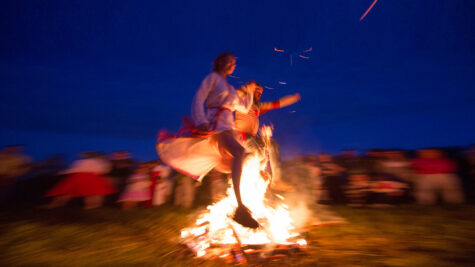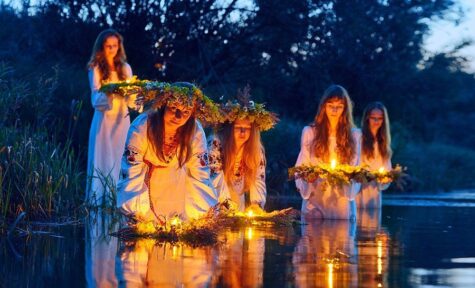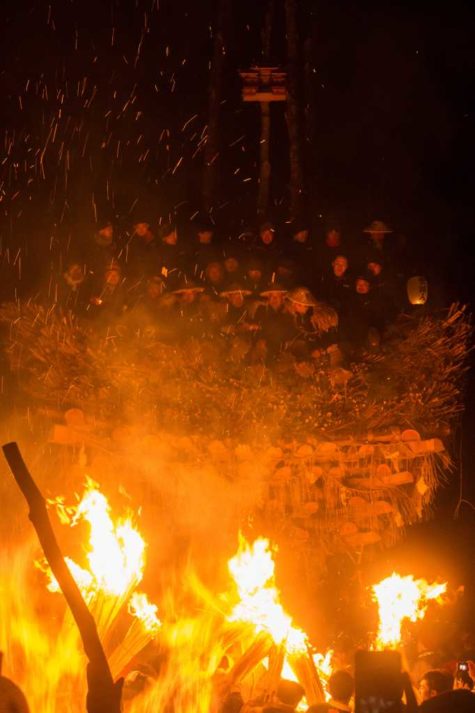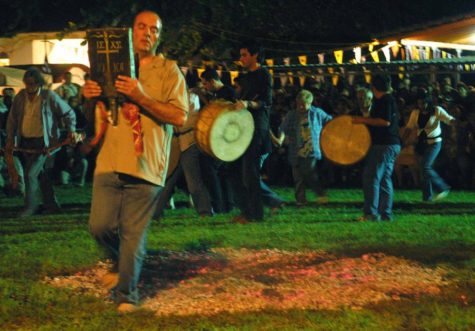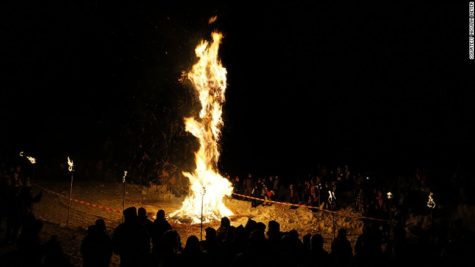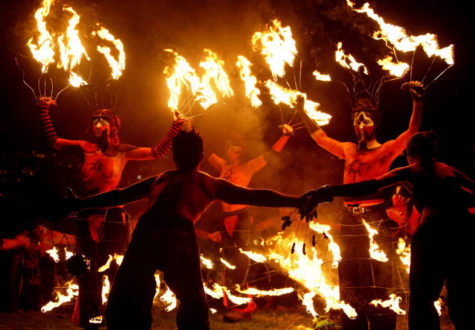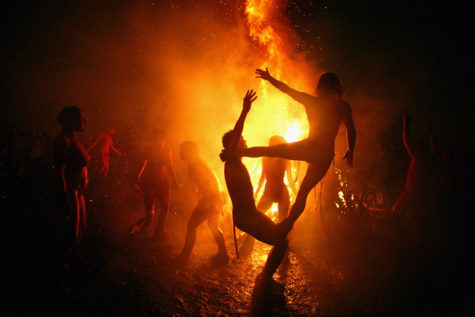Fire Festivals
According to one calendar, the ancient Greeks celebrated the ‘Feast of the Stolen Fire’ on or around November 7. I was unable to find any other mention of it, but I like the idea, so I’m adding it here. I think November is as good a time as any to celebrate the gift of fire.
Alternatively this could be celebrated on the 8th day after the November dark moon. The date will vary from year to year, but since the 8th lunar day is a day for fire, it seems appropriate.
This feast day is held in honor of the old Titan god, Prometheus, who stole fire from the gods and presented it to mortals, thus saving the human race. Many lamps were lit in his honor.
About Prometheus
Prometheus was the Titan god of forethought and crafty counsel who was given the task of molding mankind out of clay. His attempts to better the lives of his creation brought him into conflict with Zeus.
First he tricked the gods out of the best portion of the sacrificial feast, acquiring the meat for the feasting of man. Then, when Zeus withheld fire, he stole it from heaven and delivered it to mortal kind hidden inside a fennel-stalk.
As punishment for these rebellious acts, Zeus ordered the creation of Pandora (the first woman) as a means to deliver misfortune into the house of man, or as a way to cheat mankind of the company of the good spirits.
Prometheus meanwhile, was arrested and bound to a stake on Mount Kaukasos (Caucasus) where an eagle was set to feed upon his ever-regenerating liver (or, some say, heart). Generations later the great hero Herakles (Heracles) came along and released the old Titan from his torture.
For the Greeks and many who followed, Prometheus was revered as a champion of humanity, as well as a bringer of wisdom, reason, and knowledge. In Athens, the center of his ritual observance, Prometheus was credited not only as the bringer of fire, but of metallurgy as well. Alongside Athena and Hephaestus, Prometheus was celebrated by the city as a wellspring of technology, craft, and the civilized arts.
Prometheus is the archetypal figure of revolutionary defiance, chained to a rock with an eagle eating his liver, which regenerates only to be eaten again the next day. The story of Prometheus has mesmerized the imagination of philosophers, painters and poets ever since.
Despite his prominent role in their mythology, Prometheus was seldom worshipped by the ancient Greeks. His cult was limited to Athens, where, alongside Hephaestus and Athena, he served as part of an unofficial triumvirate of deities associated with technology and culture. Artisans, in particular, paid homage to Prometheus, who gave them the gifts of fire and metallurgy.
The Athenians erected an altar to Prometheus in the grove outside the Academy, a key learning center founded by Plato in the fourth century BCE. This altar served as the starting point for a torch race held during the Panathenaic festival, an Athenian civic festival held every four years.
A Ritual In Honor of Prometheus
- Colors: Blue and red
- Element: Air
- Altar: Upon cloth of blue place a great torch, a large and ugly stone with a chain laid over it, and a great curved blade laid against it.
- Offering: Stand up for something that you believe in, even if it will do you harm.
Invocation to Prometheus
Long ago, wars tore the land
And the great and powerful laid waste
To all things, and some won,
and some lost, but the true losers
Were those unfortunate humans
Who were beneath the notice of either side.
One Titan took pity on them,
And tricked the gods who would have
Robbed them of even their food,
And taught them to keep the best part
Of their sacrifices for themselves.
And then, to help them further
In the face of the wrath of the powerful,
He stole fire from the sacred forge
And gave it to weak humanity.
And for this he was punished,
As he knew he would be punished,
Chained to a stone and torn by a vulture.
And yet the knowledge of that punishment
Did not deter him from his goal,
For when there is something that must be done,
And it is right to do it,
Then harm to body and mind
Does not stop right action.
For this we hail Prometheus,
Lord of Forethought,
He who sacrifices for the good of all,
He who knows what it is to be right,
And what will be the consequences.
All stand before the altar and salute the torch, and speak of their own convictions.
A Fire Meditation
This is a day for transformation and purification.
- Purification with fire.
If possible, sit by a woodfire in the evening. Prepare yourself for complete interaction with the fire, concentrating on the flames and slipping into its energy field. Close your eyes and imagine yourself in the center of the fire. Feel how it burns out all your negative emotions and clears your energy channels.
When you feel it’s enough, imagine yourself stepping out of the fire and deeply breathe in the clear fresh air. Your channels are now filled with pure new energy, your aura is light and transparent. Realize that your aura and body have just experienced some new chemical reactions, which renewed your life.
Give thanks to the fire for your purification. If making wood-fire is impossible, practice the same meditation with candles.
Making Fire
The following is an article about starting a fire from scratch when you are camping out in the woods. I thought it would be a fun and interesting way to celebrate Prometheus and his gift of fire. Enjoy!
Hopefully, you’ll never be in the position where you won’t have any matches or lighters to start a fire with when you need one. However, no matter how cautious you are about taking fire-making instruments with you, it’s good to know more than one way to start a fire when you spend a lot of time in the great outdoors.
For example, if you’re caught in an unexpected thunderstorm, your matches might get wet, despite your best efforts to keep them in a waterproof container. Since anything can happen, be prepared for anything. Here are six ways you can start a fire without a match.
- 1. Always carry tinder.
Starting a fire from scratch is difficult enough even with matches. Without matches, it’s even harder. To give yourself a head-start on starting a fire, bring a tinder kit with you.
A tinder kit should consist of material that is dry and easy to use in the creation of a fire. You can tease apart rope fiber into soft, thin threads; cotton balls soaked in Vaseline work especially well; and you can always buy tinder kits.
If you’re caught without any tinder material on you, or if what you have has gotten wet, look for cedar trees or birch trees. The bark of these trees can be shredded to create some quick tinder. Cattails also work as natural tinder material.
- 2. Using Flint and Steel
One of the easiest match-free ways to start a fire is to use flint and steel. Flint and steel kits can be purchased relatively inexpensively and are easy to start a fire with if you have a tinder kit, especially if your tinder kit includes charcloth.
Making a fire with flint and steel has three essential steps: First, you need to create a spark. Second, you need to catch that spark. Third, you need to turn the spark into a flame.
To complete the first two steps, take a small bit of charcloth and lay it flat against the flint. Next, strike the flint with the metal striker. You should see sparks immediately if you strike the flint at the right angle.
One of these sparks should eventually land on the charcloth, giving it a tiny orange glow. That tiny glow is enough to start a fire with; you should transfer the charcloth to the tinder nest when the glow appears, gently wrapping the charcloth into the tinder nest and then blowing on it.
The tinder nest should smoke and produce a flame almost right away. You can feed the flame with small kindling, such as dried grass, pine-straw, or twigs, and then use the more stable flame to light your logs on fire.
- 3. Using a glass lens.
Some of us discovered this method quite on accident as children when we melted toys with a magnifying glass or accidentally caught bugs on fire. Hopefully, you won’t be using your magnifying glass to torture bugs when you’re on your next hiking trip, but if you have an unobstructed view of the sun, you can easily use the magnifying glass method to start a fire.
A magnifying glass that rotates in and out of a vinyl case, as opposed to a magnifying glass with a handle, is ideal for traveling with.
This method is very simple. Put your tinder nest on the ground or with your kindling, then aim the beam of the sun at the tinder nest until it begins to smoke. When it starts smoking, gently blow on the tinder nest until you produce a flame.
Using a magnifying glass to start a fire is easy, but it depends upon having a decent amount of sunlight. Since you can’t always depend on the sun being out, it’s good to have more methods on-hand than just the magnifying glass.
- 4. Capture the rays of the sun.
Besides using a glass lens to capture the rays of the sun and produce a fire, you can also use a water-filled balloon or a mirror to achieve the same effect. When using water inside a balloon, try to make the shape into a sphere. The more spherical the container is, the more effective it will be at focusing the rays of the sun.
If you don’t have a mirror on hand, you can polish the bottom of a soda/beer can with toothpaste or chocolate and turn it into a mirror. By the way, if you use this last method, don’t eat the chocolate after you’ve polished your aluminum can with it; the chocolate may contain toxic residue.
- 5. Use friction.
One of the most famous ways to start a fire without a match is also one of the most difficult: using friction. To use this method, make a v-shaped notch in a board or log, and choose a spindle that will create the friction.
Rub the spindle between your hands as fast as you can, moving your hands up and down the spindle rapidly. When the board or log begins to smoke, use your tinder nest to catch the glowing spark you’ve produced.
You can also create a bow drill instead. The bow drill is easier than the primitive method described above, but it requires you to make a proper bow first, which is harder.
- 6. When it’s wet outside.
What if you’re in a worst-case scenario type of situation? Your matches and your lighter have both gotten wet and won’t work. You have a tinder kit, along with some flint and steel, but your tinder kit has gotten wet, too. The downpour has also made the forest around you wet, so there is virtually no dry kindling or logs anywhere to be found.
Are you stuck at this point? No. If you’re resourceful, you can still start a fire.
Start by finding some dry tinder. The aforementioned birch or cedar bark works well in this scenario, but you’ll have to peel a few layers of bark off to get to the dry bark.
As for finding dry wood, look for a standing dead tree. Unlike a dead tree that’s lying on the forest floor, a standing dead tree will usually be dry inside. Peel away the rotted, wet, outer section of the tree to get to the dry wood on the inside.
You can use this dry wood as your kindling. Once you have a decent blaze going, you can use even damp limbs and twigs in your fire, because the heat of the fire will be strong enough to catch damp wood at that point.
Stealing Fire
Fire is a very powerful symbol, human progress did not begin until we established fire. The gift of fire opened the door to so many things such as cooking our food, melting metals, and providing warmth in the winter. It represents the start of civilization, consciousness, new ideas, and symbolizes man’s development of art and technology with its promise to better our lives, but not without respect for it and the gods.
Most cultures with a story to tell about fire’s origin see it as a theft. Fire is stolen, from someone who does not want to share it. Sometimes by a bird or animal blazoned with red because the fire left a scar.
Why have people always felt that fire was stolen? There’s a simple material explanation: earth, water and air, the other traditional elements of the world, are around us all the time but fire must be coaxed out of wood and stone, unless it comes down as lightning, as divine fire. Fire also needs special knowledge. You have to learn to kindle and nurture it, so it won’t go out. This knowledge must be guarded so the secret won’t be lost.
The theft of fire for the benefit of humanity is a theme that recurs in many world mythologies:
- Africa
The San peoples, the indigenous Southern African hunter-gatherers, tell how Kaggen, in the form of a mantis, brought the first fire to the people by stealing it from the ostrich, who kept the fire beneath its wings.
- Native America
Among various Native American tribes of the Pacific Northwest and First Nations, fire was stolen and given to humans by Coyote, Beaver or Dog. In Algonquin myth, Rabbit stole fire from an old man and his two daughters.
In Cherokee myth, after Possum and Buzzard had failed to steal fire, Grandmother Spider used her web to sneak into the land of light. She stole fire, hiding it in a clay pot.
According to a Mazatec legend, the opossum spread fire to humanity. Fire fell from a star and an old woman kept it for herself. The opossum took fire from the old woman and carried the flame on its tail, resulting in its hairlessness
According to the Muscogees/Creeks, Rabbit stole fire from the Weasels. In Ojibwa myth, Nanabozho the hare stole fire and gave it to humans. According to some Yukon First Nations people, Crow stole fire from a volcano in the middle of the water.
- Eurasia
According to the Rigveda, the hero Mātariśvan recovered fire, which had been hidden from humanity.
In one of the versions of Georgian myth, Amirani stole fire from metalsmiths, who refused to share it – and knowledge of creating it – with other humans.
The Vainakh hero Pkharmat brought fire to mankind and was chained to Mount Kazbek as punishment.
- Oceania
In Polynesian myth, Māui stole fire from the Mudhens. In the mythology of the Wurundjeri people of Australia, it was the Crow who stole the secret of fire from the Karatgurk women.
Sources:
Kupala Night and Ivan Kupala Day is celebrated in Ukraine, Poland, Belarus and Russia from the night of July 6 to the day of July 7 on the Gregorian calendar. This corresponds to June 23 to 24 on the traditional Julian calendar.
The celebration is linked with the summer solstice when nights are the shortest and includes a number of Slavic rituals. This holiday symbolizes the birth of the summer sun – Kupalo.
In the fourth century AD, this day was Christianized and proclaimed the holiday of the birth of John the Baptist. As a result, the pagan feast day “Kupala” was connected with the Christian “Ivan” (Russian for John) which is why the Ukrainian, Belarusian and Russian name of this holiday combines “Ivan” and Kupala which is derived from the Slavic word for bathing.
The two feasts could be connected by reinterpreting John’s baptizing people through full immersion in water. However, the tradition of Kupala predates Christianity. The pagan celebration was adapted and reestablished as one of the native Christian traditions intertwined with local folklore.

And Then It Was Banned
In the XVIII century, there were a number of documents testifying to the fierce struggle of the Church and secular authorities with the Kupala rite.
For example, in 1719 Hetman of Zaporizhzhia Army, Chairman of the Cossack state of the left bank of Ukraine, Ivan Skoropadskyi issued a decree “On parties, fisticuffs, gatherings on the holiday of Ivan Kupala etc.”, which granted the right to physically punish (tie up and beat with sticks) and excommunicate from the Church all participants of Kupala games.
In 1723, Przemysl Cathedral in Bereziv banned dancing and entertainment near the Kupala fire. In 1769, Catherine II issued a decree banning the holiday. And despite all the prohibitions, the pagan nature of folk rituals was strong. The church did not ban the holiday, but it did try to fill it with Christian content.
It is the pagan essence, mysticism, marriage-erotic motifs of Kupala rite that attracted the attention of many researchers and artists. Thanks to public ritual such art masterpieces as the Opera “Ivana Kupala” by S. Pysarevskyi; folklore work of L. Ukrainka “Kupala in Volyn”; the story of M. Gogol “Night of Ivan Kupala”; the film of Yurii Ilienko “Night on Ivan Kupala”; the Folk Opera of Y. Sankovych “When the fern blooms.” The latter during 40 years was banned and only in 2017 its world premiere took place on the stage of the Lviv Opera.
Kupala Today
At the beginning of the twentieth century Kupala rite gradually began to disappear. Today it exists in the “revived”, or rather “introduced” in Soviet times (during the anti-religious struggle) form of staged ceremony.
Although the magical meaning of rituals was leveled, and the celebration gained artistic value, the main pagan ritual actions have reached us – weaving of wreaths by girls and letting them into the water; honoring Kupala tree with dances; kindling the fire and jumping over the fire; ritual bathing; burning or sinking of trees; the burning of sacks of straw or stuffed dolls; the ceremonial dinner.
It is interesting that the name of the holiday, and the ritual fire, and decorated tree are called “Kupalo”, “Kupailo” or “Kupailytsia”. These are also the main elements of the rituals, which are based on the cult of fire, water and vegetation. Rituals symbolize the union of male (fire) and feminine (water) elements, were carried out with the aim of ensuring productivity, health, procreation.
On the territory of Ukraine for many centuries Kupala customs changed and they were not everywhere equally preserved. The majority were saved in Polissia as one of the more archaic zones of the Slavic world.
The holiday is still enthusiastically celebrated by the younger people of Eastern Europe. The night preceding the holiday (Tvorila night) is considered the night for “good humor” mischiefs (which sometimes would raise the concern of law enforcement agencies).
On Ivan Kupala day itself, children engage in water fights and perform pranks, mostly involving pouring water over people. Many of the rites related to this holiday are connected with the role of water in fertility and ritual purification.
According to ancient traditions, Ivan Kupala is the festival of the sun, and the most important role in mystical rites belongs to the power of fire. Our ancestors believed that the fire is the sun-embryo in the womb. Therefore, in the Kupala night taken to jump over the fire.
On Kupala day, young people jump over the flames of bonfires in a ritual test of bravery and faith. First, the oldest of the young men jumped over the fire.
For the highest jumpers it predicted a good harvest and prosperity for his family. Then pairs would jump, traditionally it would be a boy and a girl, but I assume that in some areas it’s permissible for pairs of any kind to take the jump together. If the couple is successful in their jump over the fire – they will certainly marry. The failure of a couple in love to complete the jump, while holding hands, is a sign of their destined separation. And anyone entering the flames during their jump can expect trouble
On the evening of July 6, unmarried girls take wreaths they have woven and throw them into the water. Unmarried men then try to grab the one belonging to the girl they are interested in. If you snag a wreath, the girl who made it will be expected to kiss you and the two of you will be paired up for the evening.
Girls may also float wreaths of flowers (often lit with candles) on rivers, in an attempt to gain foresight into their romantic relationships based from the flow patterns of the flowers on the river.
When the fun subsides, many people light candles from the hearth on pre-prepared wreath baskets and go to the river to put them on the water and thus honor their ancestors.
There is an ancient Kupala belief that the eve of Ivan Kupala is the only time of the year when ferns bloom. Prosperity, luck, discernment, and power befall whom ever finds a fern flower. Therefore, on that night, village folk roam through the forests in search of magical herbs, and especially, the elusive fern flower.
Traditionally, unmarried women, signified by the garlands in their hair, are the first to enter the forest. They are followed by young men. Therefore, the quest to find herbs and the fern flower may lead to the blooming of relationships between pairs within the forest.
It is to be noted, however, that ferns are not angiosperms (flowering plants), and instead reproduce by spores; they cannot flower.
In Gogol’s story The Eve of Ivan Kupala a young man finds the fantastical fern-flower, but is cursed by it. Gogol’s tale may have been the stimulus for Modest Mussorgsky to compose his tone poem Night on Bald Mountain, adapted by Yuri Ilyenko into a film of the same name.
Sources:
In Tabayama Village of Kitatsuru District, Yamanashi Prefecture, a (a Fire Festival dedicated to the Dōsojin or the deity of pathways and roads practiced throughout Eastern Japan. The festivity called Dondoyaki, and is celebrated between 14th and 15th January.
In this festivity, the villagers gather their Mayudama Dumplings, decorative rice dumplings made for the Japanese New Year and suspended from lines or tree tweeds. These are cooked over a bonfire and then eaten. Eating those dumplings is believed to prevent cavities, while the heat from the bonfire makes the person healthy for the rest of the year. Ashes from the fire can be used as snake and disease repellent as well as fire hazard preventative.
Alternatively known as ‘Tondo Matsuri’, ‘Sai No Kami’, ‘Sagicho’’ and Dondo Yaki’, Dōsojin Matsuri are special New Year Fire Festivals. They are held in shrines and public spaces to bless and then burn the previous year’s New Year’s decorations on a huge bonfire constructed of a wigwam of bamboo.
Shimekazari (sacred New Year decoration made from braided rice straw and good luck charms) and other New Year ornaments are taken down from homes and ceremoniously burned on the fire to secure good health and a fruitful harvest the following year. The calligraphic wishes or prayers of young children (called kakizome) are also placed onto the bonfire. As the children’s’ prayers are burnt, they are lifted up into the air towards the gods, bringing success to the children in the new year.
The loud crackling and popping sounds made by the burning bamboo is believed to tell listeners whether or not they will receive good fortune in the year to come.
Dōsojin is also the name for the Shinto guardian deities, which are closely associated with fertility in crops and people. At Dōsojin Matsuri, prayers are made to Dōsojin statues for successful births and bountiful harvests. One of the largest celebrations of Dōsojin Matsuri takes place at Nozowa Onsen in Nagana Prefecture.
Fire and snow always go well and the Nozawa Onsen Fire Festival, Nozawa Onsen Dosojin Matsuri exemplifies this as one of the three great fire festivals in Japan.
Taking place on January 15th every year, the festival is staged to celebrate the birth of a family’s first child, to dispel evil spirits and also to pray for happy marriage.
Each year crowds gather for the famous Dōsojin Matsuri, a kind of cleansing ritual for men aged 25 and 42 years, the so-called ‘unlucky ages’ in Japan. The 42-year-olds’ task is to defend a purpose-built two-story shrine, which they sit upon as it is besieged by fire at the hands of the 25-year-olds and onlookers.
It takes roughly one hundred villagers to build the shrine for the Nozawa Fire Festival. The trees are cut down in October and brought down from the mountain and through the village on January 13th prior to being made into a huge wooden structure or shaden. After the shaden has been constructed, the priest from Kosuge shrine performs a ceremony endowing it with a dosojin.
The highlight on January 15th is a “fire-setting battle” which ends up with the setting fire of the shaden with blazing torches by the offensive team and the offering of torches to the deity, making the festival truly spectacular and exciting.
The main spectacle involves a small group of 25 year old villagers guarding the base of the three story structure, and another group of very inebriated 25 year old men sitting atop the structure drinking and cheering on their teammates. Directly across from the structure, a massive bonfire is lit, which is flanked on both sides by excited visitors.
The villagers light their bamboo bundles on fire and walk in groups as large as 10 to the structure to do battle with the guards. The men at the base form human shields and use tree branches to extinguish the flames. The entire battle can last for over 2 hours and became very intense and violent at times with men shoving, jumping, slapping, and hitting each other with lit bundles of bamboo.
The entire festival is quite lengthy and can take up to four hours from the beginning to the end. Some observers gather just for the main attraction which is the battle between the guards and the torch bearing villagers. Add liberal servings of saké to all of the above and you’re sure to go home buzzing after seeing quite a spectacle – and maybe a bit scorched from the flames (don’t wear your new down jacket).
This famous Japanese festival is nationally designated as an important intangible folk cultural property. It originally began as an invocation for a good harvest, health and good fortune in the coming year, but has been expanded to include a good ski season as well.
Sources:
Burning the Devil or La Quema del Diablo is a tradition held every December 7, at 6:00 in the evening sharp, families build bonfires outside their homes and burn effigy of Satan. It is a tradition that many Guatemalans take part as a way to cleanse their home from devils that lurk in their home, creeping behind the furniture or hiding under the bed.
La quema del diablo can be traced to colonial time, a tradition that started since the 18th century. Held on the eve of the Feast of the Immaculate Conception and as a prelude to holiday season, those who could afford it adorns the fronts of their houses with lanterns, but for those who have lesser means builds a bonfires from their trash to celebrate the occasion.
A symbolical tradition with a belief that the fire burns the devil serves as purifying element, as the Virgin Mary was the blessed one to conceive baby Jesus must be free from any form of evil, therefore the event serves as “burning the devil” to clear the way for Mary’s feast.
Though the celebration may sound fun, it is controversial especially for the environmentalist groups. Back in the days, mostly paper were burned for the “cleansing ritual”, but now, piles of rubbish are mostly made of plastic and rubber that causes air pollution.
Over time the tradition evolved, from burning piles of garbage and pieces of furniture to being replaced by the effigy of Satan in a form of piñatas.
The tradition has special significance in Guatemala City because of its anticipation of Feast of the Immaculate Conception, the patron saint of the city. Along the street of Zona 1, the historic city center, many vendors pile the street selling stuffs associated with La Quema del Diablo, from firecrackers to simple and intricate devil piñatas. In different parts of the city, people celebrate and burn their own devil piñatas.
The tradition continues, as the idea is to burn all the bad from the previous year and to start anew from the ashes. It is widely observed throughout the country, The Devil is burned at the stroke of six. In Antigua, the former capital of the country, a devil three stories tall is constructed and burned in the city square.
A variation of this tradition is held in San Antonio Palopo. In this very unique celebration, they carry a statue of Maximón around town with a noose around his neck, they locals then hang Maximón by his neck in front of Catholic church, douse him with gasoline, and set him on fire. This is the local way of showing respect to the Christian god.
Setting people on fire has been a way of ridding the town of evil doers for many centuries. As soon as the Spaniards settled in Guatemala they brought with them the Christian religion. The Christian religion frowned on bloodshed. So instead they burned evil doers alive to kill them. This way they did not shed blood and therefor committed no sin.
Most of the inhabitants still pray to both the Christian and Mayan gods and deities such as Maximón or ancestors. They often ask for healing, wealth, help with love and sexual fertility.
The locals say they pray to both just in case one god does not grant their wishes the other might. This happens with both evangelical and Catholic believers. ( Not all, but the majority) This is kept secret for fear of discrimination from others.
While the many of the locals pray to both god and deities they publicly denounce Maximón shortly before Christmas by dragging him around the village then hang him with a noose and set him on fire.
The political version of this festival:
Guatemalans burn traditional devil puppets to start their Christmas celebrations. The ceremonial burning of devils started in the 16th century and is meant to chase away bad spirits. And in 2016, US president-elect Donald Trump was a big hit. But not in a good way.
Revelers in Guatemala set ablaze cardboard piñata of Trump wearing devil horns. In fact, piñata makers said Trump is far and away the best-seller. Trump’s hardline stance on immigration during his election campaign, including a promise to build a wall along the US-Mexico border, has drawn anger from Latin Americans in the US and around the world.
So this is a way to vent out the anger? It can be. Guatemalans believe the practice of torching the devil helps banish bad spirits from their homes and neighborhoods.
Sources:
“If the Saint calls you, if you have an open road, then you don’t feel the fire as if it were your enemy,”
Dating back to Pagan times, the Anastenaria is a traditional ritual ritual of fire-walking celebrated in a few places in Northern Greece and in southern Bulgaria, where Greek descendants from Thrace settled in 1923. Every year the Bulgarian and Greek villages if Aghia Eleni near Serres, Langada near Thessaloniki, Kerkini near Serres, some villages on the coast of Evros River and a singular small village near the city of Drama perform this unique annual ritual.
The central figures of the tradition are Saint Constantine and Saint Helen, but all the significant days in this cycle coincide with important days in the Greek Orthodox calendar and are related to various Christian saints.
Along with the fire-walking ritual, the 3-day festival has various processions, music, dancing and an animal sacrifice. On the eve of the feasts of Saints Constantine and Helen, while trance like rhythms of beating drums sound in the background, the Anastenarides take part in dances during which they believe that they are “seized” by the saints, and enter a state of trance. During this trance, they carry the icons of saints Constantine and Helen and dance ecstatically for hours before walking barefoot across hot coals that can reach as hot as 535 degrees Celsius.
The roots of this tradition are seeped in mystery and a bit of controversy as well. The Anastenarides say that the origin of the ritual lies in a fire which took place at Kosti, near the Black Sea in the thirteenth century which set ablaze the church of Saint Constantine. As the empty church burned, the villagers claimed to hear cries coming from the flames and believed that they were the voices of the saints calling out for help. The villagers who braved the flames to rescue them were unharmed, being protected by the saints. Neither the human protectors nor the icons were burned or hurt in any way. This occurrence prompted the annual celebration which the Anastenaria holds to honor their safe delivery.
However, many scholars do not believe this to be the true origin of the Anastenaria rituals. It is largely believed that the ceremony is the survival of an ancient Thracian Dionysian ritual which was later given a superficial Christian interpretation to help receive a better reception from the Greek Orthodox church, which does not support the rituals as they are viewed as pagan. This hasn’t stopped the Anastenarides from celebrating their age old tradition.
The two major events in this cycle are two big festivals, one in January and particularly one in May, dedicated to these two saints. Each of the festivals lasts for 3 days and involves various processions, music and dancing, and an animal sacrifice. The festival culminates with a firewalking ritual, where the participants, carrying the icons of saints Constantine and Helen, dance ecstatically for hours before entering the fire and walking barefoot over the glowing-red coals, unharmed by the fire.
Each village community of Anastenarides is headed by a “group of twelve” who, on the eve of the saints’ day, May 20 Saint Constantine and Saint Helen, gather in the “konaki”, where their holy icons are placed, as well as the “signs” of the saints (semadia), and votive offerings. These are draped with large red kerchiefs (simadia), which are believed to possess the power of the icons.
On the morning of the Saints’ day, May 21, the gather at the konaki and proceed to a well to be blessed with holy water, and sacrifice animals. The rules about the nature of the beasts to be slain are precise, but differ from village to village.
In the konaki they work themselves into a trance-like state through hours of devotional dancing to the music of the Thracian lyre and drum. The main aspect of this festival is at night, when they firewalk. In the evening a fire is lit in an open space, and after dancing for some time in the konaki, the “anastenarides” go to it carrying their ikons. After dancing around it in a circle, individual anastenarides dance over the hot coals as the saint moves them.
They make a huge fire, and when it is down to extremely hot coals, some of them (only some people are “called” to do this) walk and dance on the fire. They believe that during the dance they are “seized” by the saints.
The next day, a ritualistic sacrifice of animals takes place. After lunch the Anastenarides gather again and resume their dancing. A candle is lit from one of the oil lamps in front of the icons, and is used to light a bonfire. When the wood burns, coal is spread down.
Here is a personal account of the experience:
It’s dark outside. The moon hangs in the sky and the soft smell of smoke permeates the warm air as it stings your eyes. Looking down, you notice the glow from burning coals, as hot as 535 degrees C, scattered on the ground below. The trancelike rhythm from the beating drums fills your ears as the Patron Saints Constantine and Helen are honored in the town of Agia Eleni in Northern Greece.
he whole village surrounds you and they share in your moment, as the richness of the surrounding imagery and importance of the ritual consumes the senses. You are in a sublime state of ecstasy as the glowing coals lay before you. But, will you walk across? When Saint Constantine calls you to become a firewalker – you answer – at least if you are one of the Anastenaria.
Initially the Anastenarides dance barefoot around the hot ashes, but when the saints moves them, individuals run across the burning coals. Sometimes devotees kneel down beside the fire and pound the ashes with the palms of their hands. This continues until the ashes are cool.
During the next two days, the Anastenarides proceed around the village visiting each house. On 23 May they conclude with a second dance over the fire, although this one is in private and not for tourists.
The ritual is also performed in January, during the festival of Saint Athanasius, and fire-walking is done indoors.
Sources:
Belenus, whose name means “Bright One,” was one of the most ancient of Celtic gods. The Celtic fire festival, held on the eve of the first of May, known as Beltane, (the fires of Bel) is probably derived from the name of this deity. Beltane fires were lit to encourage the sun’s warmth. These fires also had restorative properties and cattle were herded between them before being loosed on the new spring pastures.
Closely connected to the Druids, ruler of science, healing, hot springs, fire, success, prosperity, purification, crops, vegetation, fertility. It is likely that Belenus (Bel, or Beli) was a fire deity, a patron of flame and the sun’s restorative powers (which explains his classical association with Apollo). Originally he may have been a pastoral deity and in Cymric myth is associated with cattle, sheep and crops. Though this may be because Beltane was the time that herds were moved to the high pastures.
The Celtic god of light and healing, “Bel” means “shining one,” or in Irish Gaelic, the name “bile” translates to “sacred tree.” It is thought that the waters of Danu, the Irish All-Mother goddess, fed the oak and produced their son, The Dagda. As the Welsh Beli, he is the father of Arianrhod by Don.
Patron of sheep and cattle, Bel’s festival is Beltane, one of two main Celtic fire festivals. Beltane celebrates the return of life and fertility to the world — marking the beginning of Summer and the growing season.
Taking place on April 30 (May Eve) and in some areas on May 1, Beltane also is sometimes referred to as “Cetsamhain” which means “opposite Samhain.” The word “Beltaine” literally means “bright” or “brilliant fire,” and refers to the bonfire lit by a presiding Druid in honor of Bile.
Found at: Encyclopedia Mythica
The “L’Hom Strom” festival takes place on the first Saturday in February every year the small community of Scuol in canton Graubünden, (in Switzerland close to the borders of both Austria and Italy). The “hom strom” is the famous “Straw Man of Scuol,” a large dummy.that is set alight.
On the first Saturday in February, young men crack whips to assemble the population, and the youths of Scuol, then go from farm to farm collecting straw which has been hand-threshed and especially prepared for this purpose. The straw is taken down to the village square where the thick strands of rye are then twined around a telephone pole which is almost eight meters (24 ft) long. The work must be done by noon, at which time the bundle should have reached a diameter of approximately two meters.
In the afternoon, a group of adults take the “l’hom strom” to Gurlaina and place the Hom Strom in a specially prepared hole in a field, and there set up ready for burning. The enormous effigy is carefully guarded to protect him so that pranksters – specifically the boys from the next village – cannot light him before his time!
At dusk, the people of Scuol parade through the village streets singing songs on the way to Gurlaina. As night falls, the dummy is burned, accompanied by songs to drive away the winter.When the tower clock strikes eight, the oldest boys throw balls of fire, which are rags drenched in petroleum and which have up to now illuminated the grounds, at the Hom Strom and set him aflame.
At the end of the burning ceremony attending locals sing the fourth stanza of the song Hom Strom written in the 50’s by Men Rauch, born and raised in Scuol, where a Christian adaptation is easily recognizable:
Las flommas van in ot,
portond al Segner lod,
chi’ns dosta dal malom,
eviva nos Hom Strom!!
Translation:
The flames that burn up into the sky,
give praise to the Lord,
who, in turn, protects us from evil,
long live our straw man!!…
The children and adults sing the Hom Strom song, written by a native poet. Half an hour later, the spirit of winter is consumed and everyone walks back to the village. This death by fire symbolizes the rapidly approaching end of winter.
~Info from various sources
On the winter solstice, on the longest night of the year, people would place and set afire an entire tree, that was carefully chosen and brought into the house with great ceremony. The largest end of the log would be placed into the fire hearth while the rest of the tree stuck out into the room! The log would be lit from the remains of the previous year’s log which had been carefully stored away and slowly fed into the fire through the Twelve Days of Christmas.
It was considered important that the re-lighting process was carried out by someone with clean hands.
Tradition has it that the burning of the Yule log was performed to honor the Great Mother Goddess. The log would be lit on the eve of the solstice using the remains of the log from the previous year and would be burned for twelve hours for good luck and protection.
As the fire began all other lights would be extinguished and the people would gather round the fire. In thanksgiving and appreciation for the events of the past year and in bidding the year farewell each person would toss dried holly twigs into the fire.
The next phase of the burning of the Yule log commenced with people tossing oak twigs and acorns into the fire and they would shout out their hopes and resolutions for the coming New Year and sing Yuletide carols. The celebration of the Yule log fire ended with unburned pieces of the Yule log saved to start the fire of next winter’s solstice Yule log.
The custom of the Yule Log spread all over Europe and different kids of wood are used in different countries. In England, Oak is traditional. The “mighty oak” was the most sacred tree of Europe, representing the waxing sun, symbolized endurance, strength, protection, and good luck to people in the coming year. In Scotland, it is Birch; while in France, it’s Cherry. Also, in France, the log is sprinkled with wine, before it is burnt, so that it smells nice when it is lit.
The earliest Yule Log in France can be traced back to Celtic Brittany. When the Catholic Church stamped out the Pagan tradition, it adapted. In the 12th century, the ceremony became more elaborate.
Families would haul home enormous logs and in some regions, the youngest child was allowed to ride the log home. As families dragged their logs home, passers by would raise their hats because they knew the log was full of good promises and its flame would burn out old wrongs.
For the Vikings, the yule log was an integral part of their celebration of the solstice, the julfest; on the log, they would carve runes representing unwanted traits (such as ill fortune or poor honor) that they wanted the gods to take from them.
People would also use the log as a way to predict events in the upcoming year. They would hit the burning log with tongs and the embers emitted would tell them what the harvest would be like. The more embers, the more corn. The fire was read and predictions were made for the coming year based on the sparks and flames they saw, like how many chickens or calves would be born, marriages in the family, health, wealth, etc. If the fire cast shadows on the wall, there would be a death in the family that year.
The remaining cinders would be placed in the soil so they would prevent grain diseases and produce a good harvest. They’d be spread around chicken coops to keep away foxes and in the barns and lofts where corn was stored to keep rats and weevils away. During a storm, throwing a handful into the fire would keep the house safe from lightening.
The ashes of the Yule Log were believed to hold magical and medicinal powers that would ward off evil spirits for the coming year. Ashes from the Yule log are very beneficial to garden plants, however, it is considered very unlucky to throw out the ashes of the Yule log on Christmas day.
Various chemicals can be sprinkled on the log like wine to make the log burn with different colored flames! Here’s a short list. Be sure to follow safety precautions if you plan on using them!!
- Potassium Nitrate = Violet
- Barium Nitrate = Apple Green
- Borax = Vivid Green
- Copper Sulphate = Blue
- Table Salt = Bright Yellow
Here’s how they celebrate Beltane in Edinburgh!
Enjoy!
First organized in the 1980’s, the Beltane Fire Festival has become a popular festival in Edinburgh. Here we have photos of the Beltane Fire Society celebrating Spring and the coming of summer. This lively procession celebrates the ending of winter and is a revival of the ancient Celtic festival of Beltane which is the Gaelic name for the month of May. More about Beltane can be found here: Beltane



